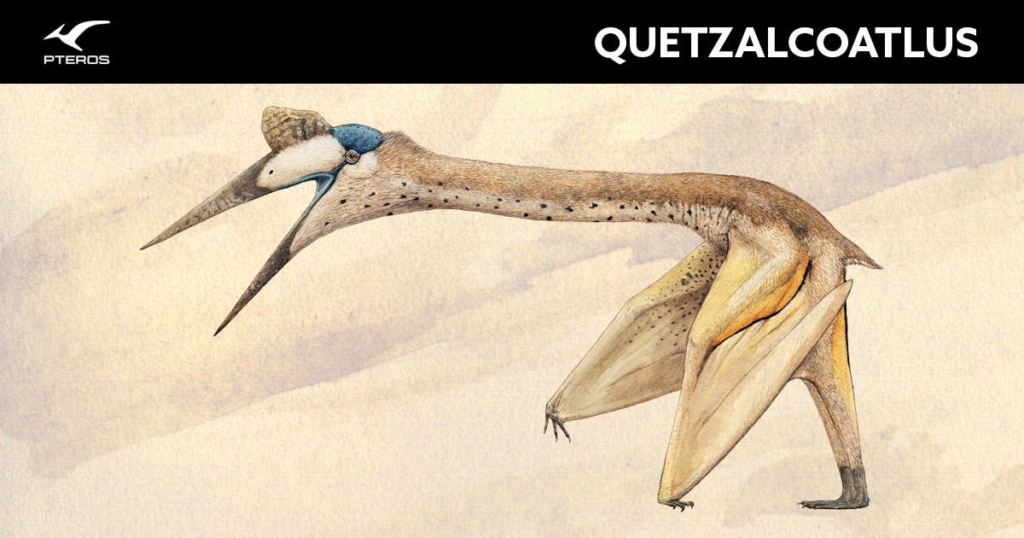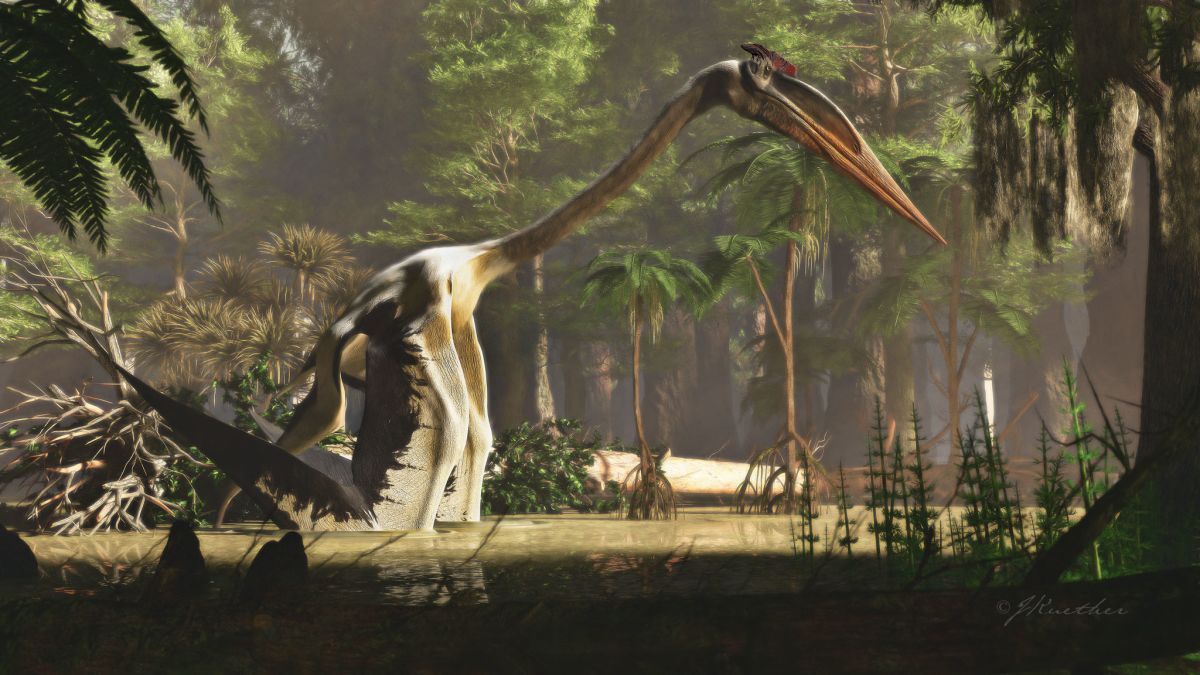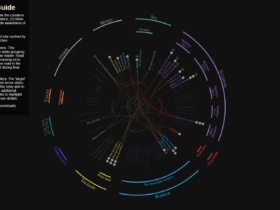Quetzalcoatlus, named after the ancient Aztec god Quetzalcoatl, is known as one of the largest flying creatures ever to exist. Living millions of years ago, this gigantic pterosaur dominated the skies over what is now North America. This article explores its size, habitat, diet, and unique characteristics.
What is Quetzalcoatlus?
Quetzalcoatlus was a type of pterosaur, a flying reptile that lived during the late Cretaceous period, around 70 to 66 million years ago. Unlike birds and bats, pterosaurs were reptiles closely related to dinosaurs, though not technically dinosaurs themselves. The name “Quetzalcoatlus” was inspired by Quetzalcoatl, the feathered serpent god of Mesoamerican mythology, a fitting name for such a majestic and mysterious creature.
This ancient flyer had a wingspan that could rival the length of a small airplane, making it one of the largest known creatures to ever take flight. Its long neck, large head, and toothless beak made it visually striking, while its skeletal structure allowed it to glide across vast distances with minimal effort. Scientists believe that Quetzalcoatlus’s ability to fly was a significant evolutionary advantage, enabling it to hunt for food over long distances and evade predators.
How Big Was Quetzalcoatlus?
Quetzalcoatlus was a true giant, with an estimated wingspan reaching up to 33 feet (10 meters). Its sheer size is awe-inspiring—when it spread its wings, it was as wide as a two-story building. However, its size varied depending on the species, with some Quetzalcoatlus individuals being smaller. The largest species, Quetzalcoatlus northropi, holds the record for the biggest flying animal, and despite its enormous size, it was relatively lightweight, which was crucial for maintaining flight.
Its body was about the size of a giraffe, standing up to 16 feet (5 meters) tall on the ground. Weighing between 440 and 550 pounds (200 to 250 kilograms), Quetzalcoatlus was relatively light for its size, thanks to hollow bones, which allowed it to be airborne. Even with its large size, this pterosaur could move swiftly both in the air and on the ground.
Where Did Quetzalcoatlus Live?
Quetzalcoatlus primarily inhabited the regions of what is now North America during the late Cretaceous period. Fossils of this creature were discovered in the Big Bend National Park in Texas, which provides valuable insights into its habitat and lifestyle. The Cretaceous period was a time when much of the region was covered by shallow seas, warm climates, and rich ecosystems that supported an array of plant and animal life.

Quetzalcoatlus in North America
The most significant discovery of Quetzalcoatlus fossils occurred in the southwestern United States, particularly in Texas. This region was ideal for Quetzalcoatlus, as it offered a mix of inland and coastal environments. The giant flyer likely used the open plains and coastal areas to hunt for food and soar long distances. The landscape provided diverse ecosystems, including rivers, wetlands, and forests, where this creature could easily thrive.
Fossil Discoveries of Quetzalcoatlus
The first Quetzalcoatlus fossil was discovered in 1971 by Douglas A. Lawson, a graduate student at the University of Texas. His groundbreaking discovery in the Big Bend region of Texas shed light on a creature previously unknown to science. Since then, additional fossils of Quetzalcoatlus have been found, but the original find remains the most significant, offering vital clues to its anatomy, behavior, and environment.
The Habitat of Quetzalcoatlus
Quetzalcoatlus lived in a time when North America was experiencing a tropical to subtropical climate, rich in vegetation, and teeming with life. Its habitat likely included coastal plains, river systems, and wetlands, areas that were abundant in food sources such as fish, smaller reptiles, and even carrion from the remains of dinosaurs. With the ability to travel long distances, Quetzalcoatlus could easily move between different environments, adapting to the resources available in each.
What Did Quetzalcoatlus Eat?
Quetzalcoatlus is believed to have been a carnivore, feeding on a variety of prey. Its long beak and powerful jaw enabled it to catch fish, small reptiles, and even smaller dinosaurs. It is also thought to have scavenged the carcasses of dead animals, much like modern vultures. Its massive wings allowed it to soar above vast areas, spotting prey from great distances.
Some scientists suggest that Quetzalcoatlus may have had a hunting technique similar to storks, swooping down to catch prey in rivers and lakes. Others believe it was capable of scavenging on land, using its long neck to reach down and snatch up food. Its diet likely included a mix of fish, small vertebrates, and possibly carrion.
Why is Quetzalcoatlus Important?
Quetzalcoatlus holds a special place in paleontology because it represents the pinnacle of flying reptile evolution. It was one of the last and largest pterosaurs to live before the mass extinction event that wiped out the dinosaurs and many other species around 66 million years ago. Understanding Quetzalcoatlus helps scientists learn more about how giant creatures like this could fly, survive, and dominate their ecosystems.
Furthermore, studying Quetzalcoatlus provides insights into the biodiversity of the late Cretaceous period and how ecosystems were structured. As one of the largest flying creatures, Quetzalcoatlus exemplifies the adaptability and evolutionary success of pterosaurs, demonstrating how these reptiles thrived in a world dominated by dinosaurs.
Quetzalcoatlus vs. Other Flying Reptiles
While Quetzalcoatlus was the largest flying reptile, it was not the only one. Several other pterosaurs roamed the skies during the Mesozoic era. However, Quetzalcoatlus stood out for its size and unique features that gave it a competitive edge over its flying relatives.

Quetzalcoatlus vs. Pterodactyl
Pterodactyls are perhaps the most famous pterosaurs, but they were much smaller than Quetzalcoatlus. While Pterodactyls had wingspans of around 3 to 5 feet (1 to 1.5 meters), Quetzalcoatlus dwarfed them with its colossal 33-foot wingspan. Both creatures had hollow bones and similar beak structures, but Quetzalcoatlus’s massive size allowed it to cover greater distances and prey on larger animals.
How Quetzalcoatlus Dominated the Skies
Quetzalcoatlus’s massive wingspan and lightweight build made it the master of the skies. It could soar for hours without flapping its wings, gliding on thermal currents to cover vast distances with minimal effort. Its large eyes helped it spot prey from far above, and its impressive wingspan allowed it to reach great heights.
Differences Between Quetzalcoatlus and Other Flyers
Quetzalcoatlus had several distinct differences from other flying reptiles. Its long neck and toothless beak set it apart from smaller pterosaurs, which often had teeth and shorter necks. Quetzalcoatlus’s size also gave it an advantage in terms of hunting and defense, allowing it to dominate its environment both in the air and on the ground.
What Makes Quetzalcoatlus Unique?
Quetzalcoatlus was unique not only because of its size but also because of its incredible adaptations for flight. Its long wings, hollow bones, and lightweight structure enabled it to glide effortlessly across great distances. Unlike many pterosaurs, Quetzalcoatlus had a toothless beak, making it more similar to modern birds in appearance. Its ability to thrive in a variety of environments—from coastal plains to inland regions—also made it a highly adaptable predator.
The Bottom Line
Quetzalcoatlus remains one of the most fascinating creatures to have ever lived. Its enormous size, combined with its unique adaptations, allowed it to dominate the skies of late Cretaceous North America. As one of the largest flying animals in history, it continues to capture the imagination of scientists and dinosaur enthusiasts alike. Studying Quetzalcoatlus gives us a window into a world long gone, showing how life adapted and thrived millions of years ago.














Leave a Reply